2009 FIAT DUCATO roof
[x] Cancel search: roofPage 210 of 282
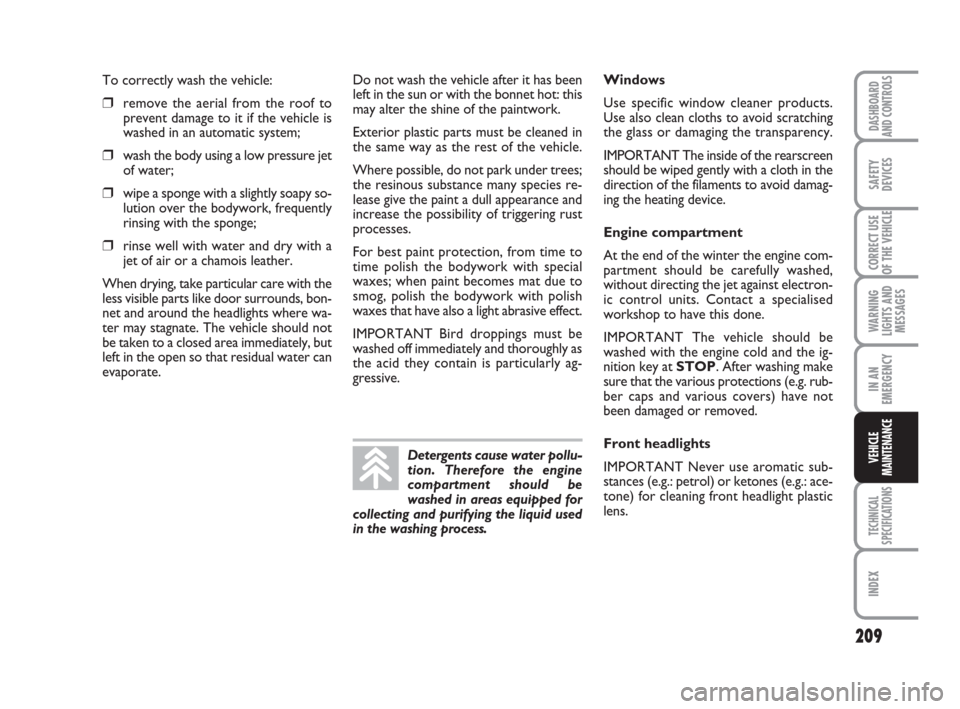
209
WARNING
LIGHTS AND
MESSAGES
TECHNICAL
SPECIFICATIONS
INDEX
DASHBOARD
AND CONTROLS
SAFETY
DEVICES
CORRECT USE
OF THE VEHICLE
IN AN
EMERGENCY
VEHICLE
MAINTENANCE
To correctly wash the vehicle:
❒remove the aerial from the roof to
prevent damage to it if the vehicle is
washed in an automatic system;
❒wash the body using a low pressure jet
of water;
❒wipe a sponge with a slightly soapy so-
lution over the bodywork, frequently
rinsing with the sponge;
❒rinse well with water and dry with a
jet of air or a chamois leather.
When drying, take particular care with the
less visible parts like door surrounds, bon-
net and around the headlights where wa-
ter may stagnate. The vehicle should not
be taken to a closed area immediately, but
left in the open so that residual water can
evaporate.Do not wash the vehicle after it has been
left in the sun or with the bonnet hot: this
may alter the shine of the paintwork.
Exterior plastic parts must be cleaned in
the same way as the rest of the vehicle.
Where possible, do not park under trees;
the resinous substance many species re-
lease give the paint a dull appearance and
increase the possibility of triggering rust
processes.
For best paint protection, from time to
time polish the bodywork with special
waxes; when paint becomes mat due to
smog, polish the bodywork with polish
waxes that have also a light abrasive effect.
IMPORTANT Bird droppings must be
washed off immediately and thoroughly as
the acid they contain is particularly ag-
gressive.
Detergents cause water pollu-
tion. Therefore the engine
compartment should be
washed in areas equipped for
collecting and purifying the liquid used
in the washing process.
Windows
Use specific window cleaner products.
Use also clean cloths to avoid scratching
the glass or damaging the transparency.
IMPORTANT The inside of the rearscreen
should be wiped gently with a cloth in the
direction of the filaments to avoid damag-
ing the heating device.
Engine compartment
At the end of the winter the engine com-
partment should be carefully washed,
without directing the jet against electron-
ic control units. Contact a specialised
workshop to have this done.
IMPORTANT The vehicle should be
washed with the engine cold and the ig-
nition key at STOP. After washing make
sure that the various protections (e.g. rub-
ber caps and various covers) have not
been damaged or removed.
Front headlights
IMPORTANT Never use aromatic sub-
stances (e.g.: petrol) or ketones (e.g.: ace-
tone) for cleaning front headlight plastic
lens.
Page 231 of 282
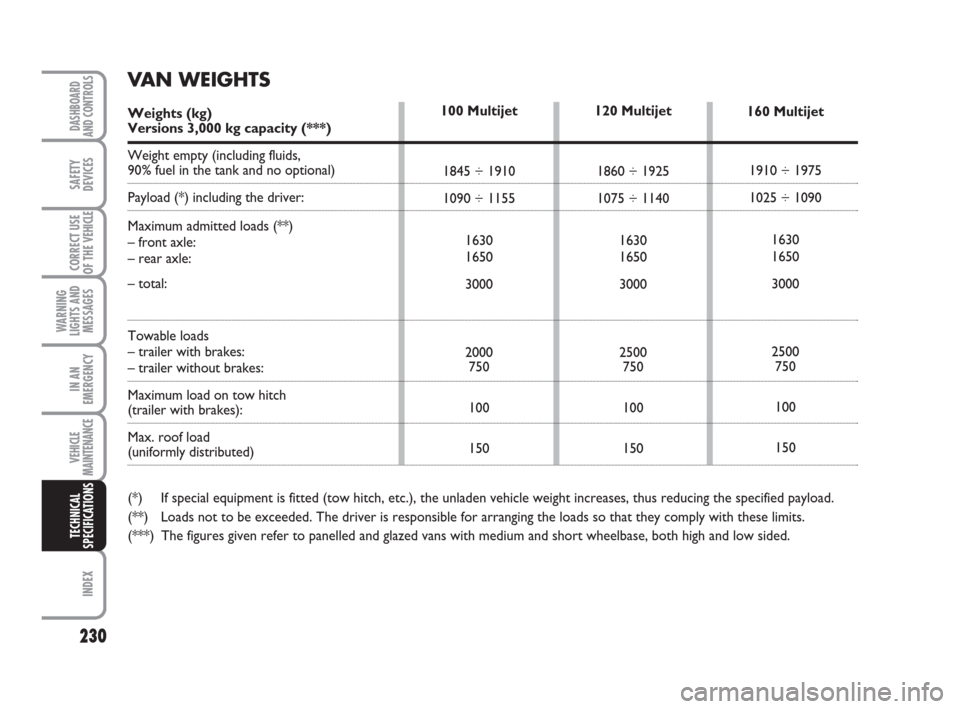
230
WARNING
LIGHTS AND
MESSAGES
INDEX
DASHBOARD
AND CONTROLS
SAFETY
DEVICES
CORRECT USE
OF THE
VEHICLE
IN AN
EMERGENCY
VEHICLE
MAINTENANCE
TECHNICAL
SPECIFICATIONS
120 Multijet
1860 ÷ 1925
1075 ÷ 1140
1630
1650
3000
2500
750
100
150160 Multijet
1910 ÷ 1975
1025 ÷ 1090
1630
1650
3000
2500
750
100
150 100 Multijet
1845 ÷ 1910
1090 ÷ 1155
1630
1650
3000
2000
750
100
150
VAN WEIGHTS
Weights (kg)Versions 3,000 kg capacity (***)
Weight empty (including fluids,
90% fuel in the tank and no optional)
Payload (*) including the driver:
Maximum admitted loads (**)
– front axle:
– rear axle:
– total:
Towable loads
– trailer with brakes:
– trailer without brakes:
Maximum load on tow hitch
(trailer with brakes):
Max. roof load
(uniformly distributed)
(*) If special equipment is fitted (tow hitch, etc.), the unladen vehicle weight increases, thus reducing the specified payload.
(**) Loads not to be exceeded. The driver is responsible for arranging the loads so that they comply with these limits.
(***) The figures given refer to panelled and glazed vans with medium and short wheelbase, both high and low sided.
Page 232 of 282
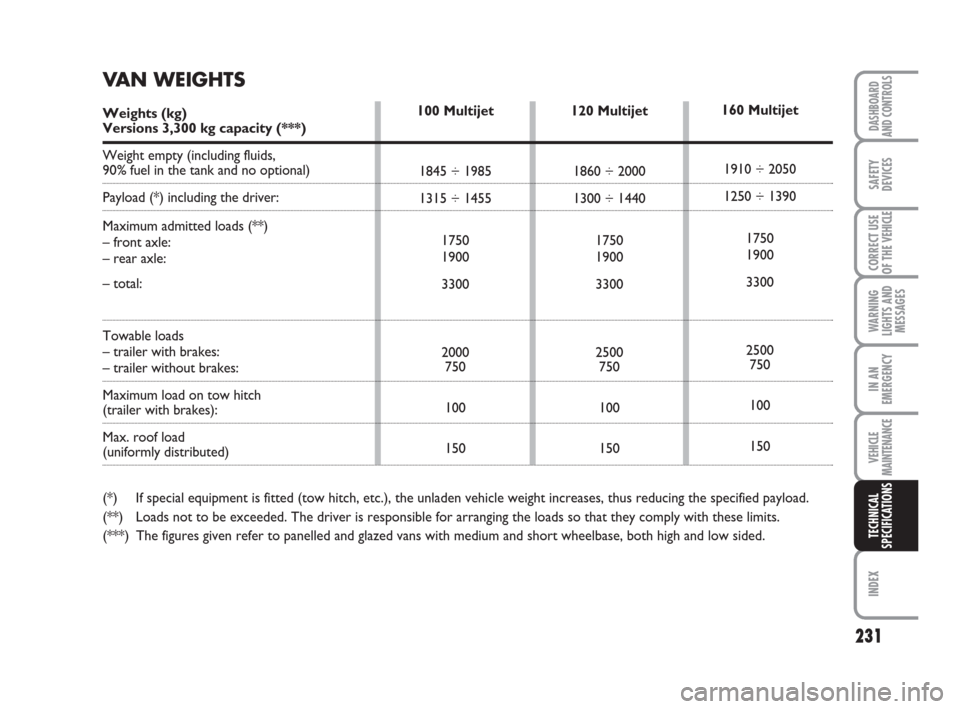
231
WARNING
LIGHTS AND
MESSAGES
INDEX
DASHBOARD
AND CONTROLS
SAFETY
DEVICES
CORRECT USE
OF THE
VEHICLE
IN AN
EMERGENCY
VEHICLE
MAINTENANCE
TECHNICAL
SPECIFICATIONS
120 Multijet
1860 ÷ 2000
1300 ÷ 1440
1750
1900
3300
2500
750
100
150160 Multijet
1910 ÷ 2050
1250 ÷ 1390
1750
1900
3300
2500
750
100
150 100 Multijet
1845 ÷ 1985
1315 ÷ 1455
1750
1900
3300
2000
750
100
150
VAN WEIGHTS
Weights (kg)Versions 3,300 kg capacity (***)
Weight empty (including fluids,
90% fuel in the tank and no optional)
Payload (*) including the driver:
Maximum admitted loads (**)
– front axle:
– rear axle:
– total:
Towable loads
– trailer with brakes:
– trailer without brakes:
Maximum load on tow hitch
(trailer with brakes):
Max. roof load
(uniformly distributed)
(*) If special equipment is fitted (tow hitch, etc.), the unladen vehicle weight increases, thus reducing the specified payload.
(**) Loads not to be exceeded. The driver is responsible for arranging the loads so that they comply with these limits.
(***) The figures given refer to panelled and glazed vans with medium and short wheelbase, both high and low sided.
Page 233 of 282
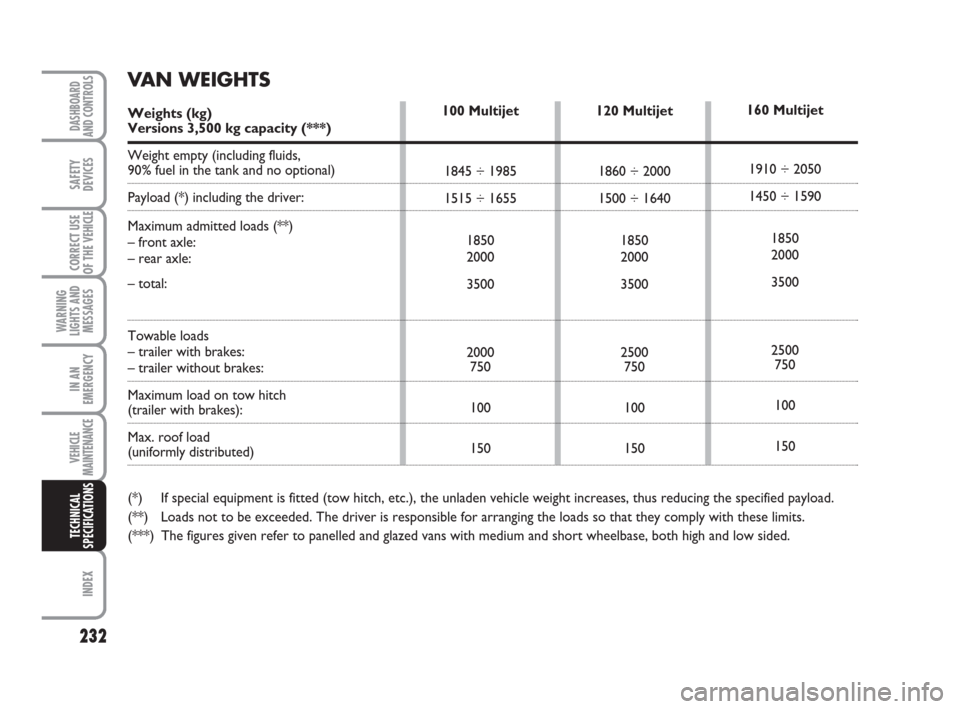
232
WARNING
LIGHTS AND
MESSAGES
INDEX
DASHBOARD
AND CONTROLS
SAFETY
DEVICES
CORRECT USE
OF THE
VEHICLE
IN AN
EMERGENCY
VEHICLE
MAINTENANCE
TECHNICAL
SPECIFICATIONS
120 Multijet
1860 ÷ 2000
1500 ÷ 1640
1850
2000
3500
2500
750
100
150160 Multijet
1910 ÷ 2050
1450 ÷ 1590
1850
2000
3500
2500
750
100
150 100 Multijet
1845 ÷ 1985
1515 ÷ 1655
1850
2000
3500
2000
750
100
150
VAN WEIGHTS
Weights (kg)Versions 3,500 kg capacity (***)
Weight empty (including fluids,
90% fuel in the tank and no optional)
Payload (*) including the driver:
Maximum admitted loads (**)
– front axle:
– rear axle:
– total:
Towable loads
– trailer with brakes:
– trailer without brakes:
Maximum load on tow hitch
(trailer with brakes):
Max. roof load
(uniformly distributed)
(*) If special equipment is fitted (tow hitch, etc.), the unladen vehicle weight increases, thus reducing the specified payload.
(**) Loads not to be exceeded. The driver is responsible for arranging the loads so that they comply with these limits.
(***) The figures given refer to panelled and glazed vans with medium and short wheelbase, both high and low sided.
Page 234 of 282
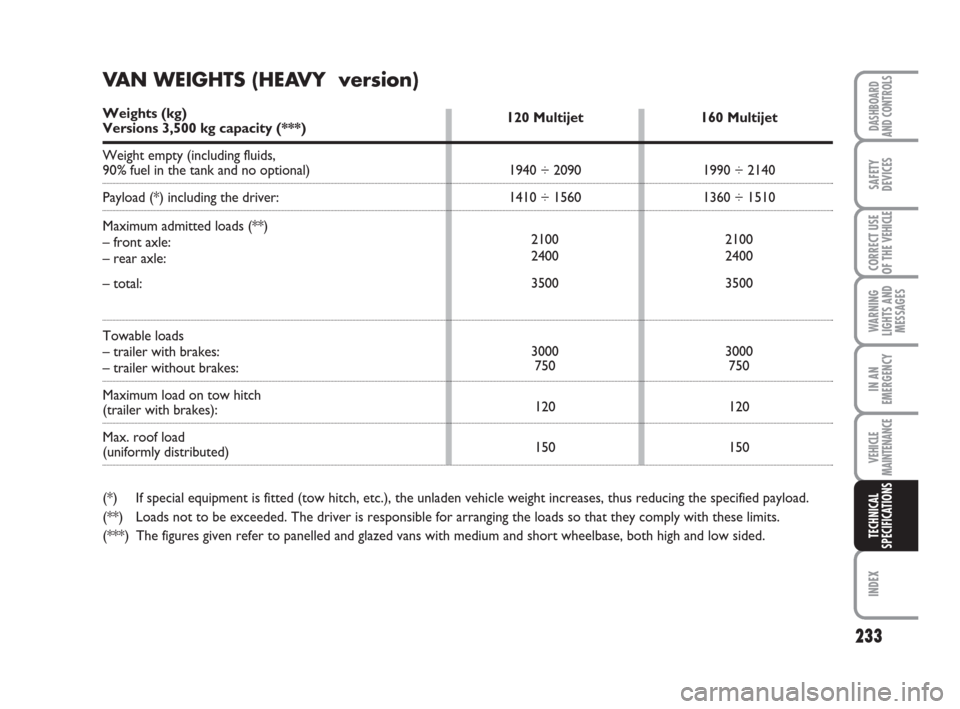
233
WARNING
LIGHTS AND
MESSAGES
INDEX
DASHBOARD
AND CONTROLS
SAFETY
DEVICES
CORRECT USE
OF THE
VEHICLE
IN AN
EMERGENCY
VEHICLE
MAINTENANCE
TECHNICAL
SPECIFICATIONS
120 Multijet
1940 ÷ 2090
1410 ÷ 1560
2100
2400
3500
3000
750
120
150160 Multijet
1990 ÷ 2140
1360 ÷ 1510
2100
2400
3500
3000
750
120
150
VAN WEIGHTS (HEAVY version)
Weights (kg)Versions 3,500 kg capacity (***)
Weight empty (including fluids,
90% fuel in the tank and no optional)
Payload (*) including the driver:
Maximum admitted loads (**)
– front axle:
– rear axle:
– total:
Towable loads
– trailer with brakes:
– trailer without brakes:
Maximum load on tow hitch
(trailer with brakes):
Max. roof load
(uniformly distributed)
(*) If special equipment is fitted (tow hitch, etc.), the unladen vehicle weight increases, thus reducing the specified payload.
(**) Loads not to be exceeded. The driver is responsible for arranging the loads so that they comply with these limits.
(***) The figures given refer to panelled and glazed vans with medium and short wheelbase, both high and low sided.
Page 235 of 282
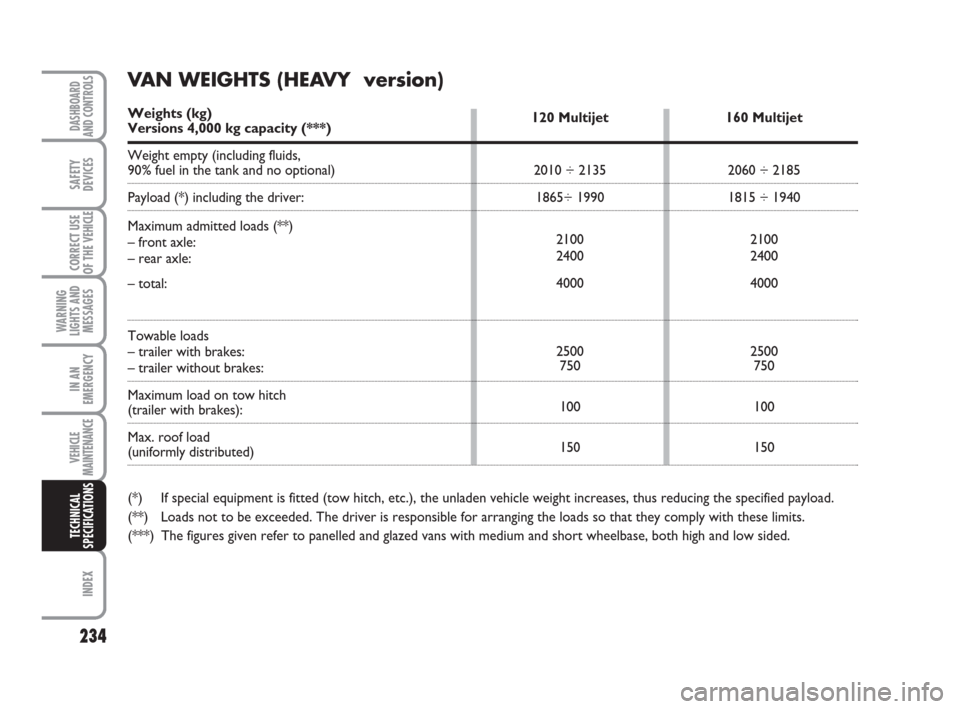
234
WARNING
LIGHTS AND
MESSAGES
INDEX
DASHBOARD
AND CONTROLS
SAFETY
DEVICES
CORRECT USE
OF THE
VEHICLE
IN AN
EMERGENCY
VEHICLE
MAINTENANCE
TECHNICAL
SPECIFICATIONS
120 Multijet
2010 ÷ 2135
1865÷ 1990
2100
2400
4000
2500
750
100
150160 Multijet
2060 ÷ 2185
1815 ÷ 1940
2100
2400
4000
2500
750
100
150
VAN WEIGHTS (HEAVY version)
Weights (kg)Versions 4,000 kg capacity (***)
Weight empty (including fluids,
90% fuel in the tank and no optional)
Payload (*) including the driver:
Maximum admitted loads (**)
– front axle:
– rear axle:
– total:
Towable loads
– trailer with brakes:
– trailer without brakes:
Maximum load on tow hitch
(trailer with brakes):
Max. roof load
(uniformly distributed)
(*) If special equipment is fitted (tow hitch, etc.), the unladen vehicle weight increases, thus reducing the specified payload.
(**) Loads not to be exceeded. The driver is responsible for arranging the loads so that they comply with these limits.
(***) The figures given refer to panelled and glazed vans with medium and short wheelbase, both high and low sided.
Page 265 of 282

264
WARNING
LIGHTS AND
MESSAGES
INDEX
DASHBOARD
AND CONTROLS
SAFETY
DEVICES
CORRECT USE
OF THE
VEHICLE
IN AN
EMERGENCY
VEHICLE
MAINTENANCE
TECHNICAL
SPECIFICATIONS
❒extra-urban cycle: frequent acceler-
ating in all gears, simulating extraurban
use of the vehicle; the speed varies be-
tween 0 and 120 km/h;
❒combined consumption: is calculated
weighing about 37% of urban cycle
consumption and about 63% of ex-
traurban consumption.
FUEL CONSUMPTION
The fuel consumption figures given in
the table below are determined on the
basis of the homologation tests set
down by specific European Directives.
The procedures below are followed for
measuring consumption:
❒urban cycle: cold starting followed by
driving that simulates urban use of
the vehicle;IMPORTANT The type of route, traffic
situations, weather conditions, driving
style, general conditions of the vehicle,
trim level/equipment/accessories, load, cli-
mate control system, roof rack, other sit-
uations that affect air drag may lead to dif-
ferent fuel consumption levels than those
measured.
Light (Short Wheel-Base) (*)
Light (Medium-Wheel Base) (*)
Light (Short Wheel-Base) (*)
Light (Medium-Wheel Base) (*)
Heavy (
●)
Light (Short Wheel-Base) (*)
Light (Medium-Wheel Base) (*)
Heavy (
●)8.2
8.5
8.3
8.8
8.9
9.4
9.9
10.26.8
7.0
6.5
6.8
6.7
6.9
7.2
7.67.3
7.6
7.2
7.5
7.5
7.8
8.2
8.6 100 Multijet
120 Multijet
160 Multijet COMBI Versions – According to European Directive in force (litres/100km)
Loading Capacity Consumption
Urban Extra-urban Combined
(*) Departure in 2ndgear
(
●) With specific pneumatic and transmission ratios
Page 273 of 282

272
WARNING
LIGHTS AND
MESSAGES
DASHBOARD
AND CONTROLS
SAFETY
DEVICES
CORRECT USE
OF THE
VEHICLE
IN AN
EMERGENCY
VEHICLE
MAINTENANCE
TECHNICAL
SPECIFICATIONS
INDEX
Oddment compartment under
the front passenger's seat ............... 86
Oddment compartments .................. 85
Operation at low temperatures ...... 110
Paint ..................................................... 208
Parking .................................................. 136
Parking sensors ................................... 107
Performance ........................................ 229
Plates
– body paint....................................... 213
– identification data.......................... 212
Pollen filter............................................ 202
Power steering fluid level................... 201
Power windows
– controls .......................................... 97
Pretensioners........................................ 116
Protecting the environment ............. 112
Radio-controlled remote control
– government type-approval.......... 266
Radio transmitters and cellular
telephones.......................................... 110
Rain sensor .......................................... 78
Reading/writing desk........................... 88
Rear ceiling lights– bulb replacement .......................... 176
– control............................................. 82
Rear double door................................ 96
Rear fog lights
– bulb replacement .......................... 173
– control button .............................. 83
Rearview camera .............................40-89
Rearview mirrors................................. 45
– door mirrors ................................. 45
– driving mirror ................................ 45
– electric ............................................ 46
Refrigerated compartment................ 85
Refuelling .............................................. 111
Rev counter ......................................... 18
Reversing light ..................................... 173
Rims
– understanding rim marking.......... 220
Roof rack/ski rack................................ 100
Safety devices...................................... 113
Seat adjustment ................................... 37
Seat belts............................................... 114
– general warnings ........................... 117
– load limiters.................................... 116
– maintenance .................................. 109 Interiors ................................................ 209
Isofix....................................................... 124
Jacking the vehicle .............................. 186
Key with remote control ................ 9
Key without remote control ........... 11
Levels
– brake fluid ...................................... 200
– engine coolant ............................... 199
– engine oil ........................................ 198
– power steering fluid ..................... 201
– windscreen/rear window/
headlight washer............................ 200
Load limiters ........................................ 116
Main beam headlights
– bulb replacement .......................... 171
– control ............................................ 75
– flashing ............................................ 75
Manual climate control system ......... 51
Mobile footboard................................. 95
Multifunction display .......................... 26
Multimeter ........................................... 91
Number plate light ............................ 175